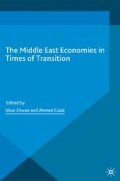Abstract
On December 19, 2010, Iran embarked on an ambitious reform of its extensive subsidies. Energy prices that had been kept well below international levels for decades were raised by a factor of 3 to 9 and bread prices were doubled. Energy price reform had been discussed for at least a decade, and the specific plan for this particular reform program was announced by president Ahmadinejad in 2008 and enacted into law in January 2010. This attempt at reform ended a huge government subsidy, estimated at upwards of $70 billion per year, or nearly $1000 per person per year. It was distributed highly unequally and caused Iran’s productive sectors to become the least efficient in the world (Guillaume et al 2011, IEA 2010, Salehi-Isfahani et al 2012).
The research for this policy brief was supported by a grant from the ERF RIAD initiative. I am grateful to the Statistical Center of Iran for the survey data. This paper first appeared as ERF Policy Perspective No. 13, 2014.
Access this chapter
Tax calculation will be finalised at checkout
Purchases are for personal use only
Preview
Unable to display preview. Download preview PDF.
References
Farzin, M. R. 2014. The source of the exchange rate shock in 2011. [In Persian]. Pars News Agency. http://www.farsnews.com/newstext.php?nn=13921119001178.
Guillaume, Dominique, Roman Zytek, and Mohammad Reza Farzin. 2011. Iran-The Chronicles of the Subsidy Reform. IMF Working Papers, 1–28.
International Energy Agency (2010). World energy outlook 2010. Paris, France: International Energy Agency.
Salehi-Isfahani, D. (2009). Poverty, inequality, and populist politics in Iran. Journal of Economic Inequality 15 (1): 5–24.
Salehi-Isfahani, D. (2014) Rouhani’s spoiled food? An Iranian aid program raises questions. Iran Matters. February 14. http://iranmatters.belfercenter.org/blog/rouhani’s-spoiled-food-iranian-aid-program-raises-questions.
Salehi-Isfahani, D., B. Stucki, and J. Deutschmann. 2012. The reform of energy subsidies in Iran: The role of cash transfers. Emerging Markets Finance and Frade.
Statistical Center of Iran, Household Expenditures and Incomes Survey, various years. Tehran, Iran.
Editor information
Editors and Affiliations
Copyright information
© 2016 International Economic Association
About this chapter
Cite this chapter
Salehi-Isfahani, D. (2016). Energy Subsidy Reform in Iran. In: Diwan, I., Galal, A. (eds) The Middle East Economies in Times of Transition. International Economic Association Series. Palgrave Macmillan, London. https://doi.org/10.1007/978-1-137-52977-0_7
Download citation
DOI: https://doi.org/10.1007/978-1-137-52977-0_7
Publisher Name: Palgrave Macmillan, London
Print ISBN: 978-1-137-58394-9
Online ISBN: 978-1-137-52977-0
eBook Packages: Economics and FinanceEconomics and Finance (R0)

